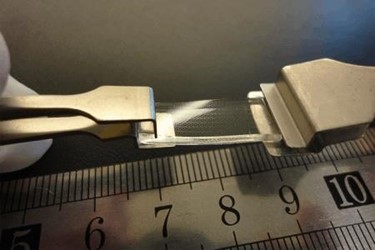MIT Researchers Use Chalcogenides To Stretch And Integrate Photonic Devices
By Jof Enriquez,
Follow me on Twitter @jofenriq

Scientists at the Massachusetts Institute of Technology (MIT) are using chalcogenide glasses to produce flexible hybrid electronics (FHE) that can stretch or conform to the shape of an object or structure without damage, and to better integrate two-dimensional (2D) materials with conventional semiconductor circuits.
FHE technology is set to improve medical monitoring in the form of smart bandages that collect vital signs and deliver drugs, and can even improve aerodynamics by potentially eliminating the mechanically actuated dish antennas used on many modern aircraft in favor of integrated phased array antennas.
Most current flexible materials used for FHE devices, though, possess a low refractive index, which reduces their ability to confine a light beam to carry the needed information.
As an alternative, MIT researchers considered a more efficient, but rigid, material called chalcogenide. Widely considered as a promising material for photonic applications, chalcogenide glasses are transparent from the visible to the near infrared region, and can be molded into different shapes like flat lenses or fibers.
For their research study, to be published in Light: Science and Applications, the MIT team led by Juejun Hu, who is the Merton C. Flemings Associate Professor of Materials Science & Engineering Associate Professor, experimented in turning a thin layer of chalcogenide into a spring-like coil, a shape which allows the material to retain its desired optical properties while allowing it to stretch thousands of times.
“You end up with something as flexible as rubber, that can bend and stretch, and still has a high refractive index and is very transparent,” said Hu.
The flexible, spring-like waveguides were held in place in an epoxy resin matrix, which was made stiffer near the optical components and more flexible around the waveguides, according to MIT News.
Hu said it will take the researchers another two to three years before they can successfully combine all the necessary photonic components on a single device and commercialize these into products, which may include skin-mounted monitoring devices that use optical signals to measure heart rate, blood oxygen levels, and blood pressure.
A more immediate application of chalcogenide glass could be its use to more effectively integrate 2D materials, such as graphene, with conventional semiconductor photonic circuitry.
In a separate paper published last week in Nature Photonics, Hu and colleagues described a new method that allows layers of chalcogenide glass and 2D materials to be fabricated directly on the semiconductor surface at room temperature. The process is an improvement over current methods wherein these photonic materials need to be made on one surface before being peeled off, and then transferred to the semiconductor wafer, according to MIT News.
The chalcogenide material also serves as protection (a passivation layer) for integrated 2D materials from ambient moisture, which could degrade their optoelectronic characteristics.
MIT is a key player in programs to develop stretchable, bendable, and wearable next-generation electronics. It is a member of several consortia dedicated to this endeavor, including, the American Institute for Manufacturing Integrated Photonics (AIM Photonics), Lightweight Innovations for Tomorrow (LIFT), and the Manufacturing Innovation Institute for Flexible Hybrid Electronics.
